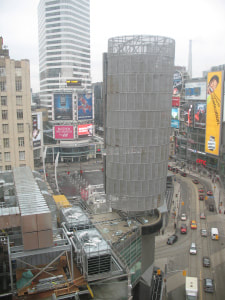|
So, April 20, here I am in Toronto. I was scheduled to examine sashes at the Canadian Textile Museum at 11. This gave me time after breakfast to check out Romni Wools … yes, there is a reason that Ontario weavers and fiber artists rave about this store. What an amazing collection of yarn!
Yes, I did move on the the Textile Museum. Roxanne had three splendid fingerwoven sashes out for my examination. All three were in the classic arrow-and-lightning pattern. One particularly captivated my interest. The weaver must have had a rough time. It looks to me like there may be evidence of a number of problems my students face … and some clever solutions. -losing the shed -weaving too far -checkerboardingOK, in the category of losing the shed. I recommend the use of a ‘safety belt’ to tie off one group of threads whenever you pause in your work to keep the upper and lower threads separate. The error I saw on this sash entailed two different spots where a whole row (or significant portion thereof) exhibited an awful disorganization in the threads. I am thinking that this weaver lost the shed, and instead of meticulously re-establishing the shed, this clever weaver just buffaloed on, and you don’t much notice until you look closely. Second problem, weaving too far. In the arrow-and-lightning pattern, weft-to-warp changes are supposed to happen at regular intervals. It looks to me like the weaver of this sash occasionally went too far with a weft. When this happens to me, I work backwards, unweaving as I go across the row to the spot where the change is supposed to happen. The clever weaver here did not work backwards, but rather just pulled the weft between the shed back to the right place, and dragged the proper color on over. With the next row, yes there were three threads in the shed … maybe this needs a diagram. It’s a clever solution to a common problem. The third anomaly in the sash was the presence of short rows. In knitting, particularly at the neck of a sweater, a person sometimes works only part way across, not using all the stitches before turning. This causes the work to grow a bit more in a selected spot. In this sash, I saw evidence of short rows at the outside color zones for the first half of the sash, and near the central arrow in the second half of the sash. Now, I’m not sure about these short rows at the outside edges. I have seen it before, and my theory is that the weaver felt that the thread in the outer color zones was perhaps a bit thinner than that in the central arrowhead and center color zones. This might be the way to make up for this difference in thread size. As I say, I have seen this in other sashes. Where it is present it is not always consistently done throughout the full sash. The sashes seem to lay quite flat, equally in the areas with the short rows and in the areas without. Anyhow, the feature of this sash that I think might be of interest to weavers was the use of short rows in the second half of the sash … in the lightnings immediately to the side of the arrowhead. I am thinking that this technique could help those weavers who are chronically plagued by checkerboarding. Extra rows, extending from the center and weaving through only the first two or three lightnings increases the length, relieves the puckering and eliminates the checkerboarding caused by too much tension on the center threads…this is my theory to explain the odd presence of this feature of the sash. After lunch I headed out to Peterborough by Greyhound. I had a lovely chat with Beth, Ipie and Jeremy, about sash weaving and sash wearing, and speculation concerning the origin of this special design. Then the real treat, a quick tour of the Canadian Canoe Museum. Any of you who read this and who are in the area, go visit the Canadian Canoe Museum and the Canadian Textile Museum. Both definitely worth the trip!
0 Comments
Your comment will be posted after it is approved.
Leave a Reply. |
Categories
All
Archives
May 2023
Categories
All
|

 RSS Feed
RSS Feed